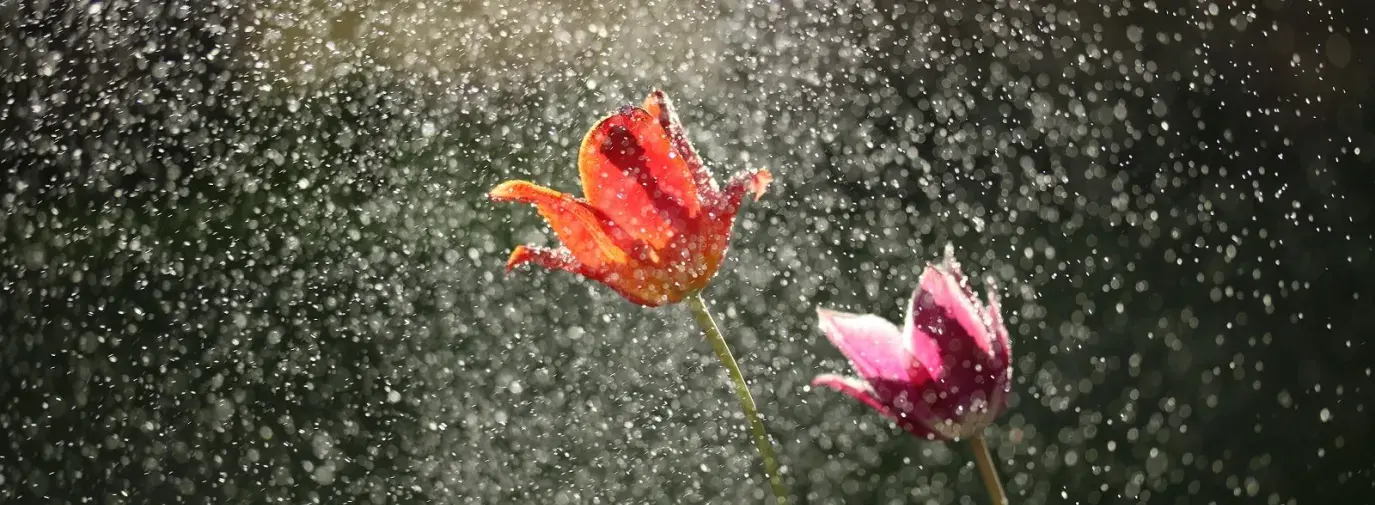
When Bob Hamler decided to install a rain barrel in his backyard, he didn’t expect to start a neighborhood trend. Bob’s wife Maxine, who loves tending to their backyard garden, recommended that they get a rain barrel to collect water to use in the garden.
“It made so much sense!” says Maxine, “I knew it was a great way to cut our water bills and water our garden.”
A rain barrel is a water catchment system than you can easily set up in your yard. All you need to do is find a large plastic barrel, and install a screen over the top and a faucet at the bottom. Rain will run off your roof and into the barrel (placed strategically under a rain gutter downspout). The screen will catch debris, and you can attach a hose to the faucet and use the water as needed.
Bob was amazed by how easy the rain barrel was to put together. He found all the parts he needed at his local hardware store, and it took him less than an hour to assemble them into a functioning rain barrel. Soon the Hamlers’ do-it-yourself project was the talk of the neighborhood; people were impressed by the simple yet efficient design. Many of Bob’s neighbors soon got rain barrels of their own.
“Around here, you hear about water shortages all the time,” says Hamler, who lives in Florida. “I feel great that I can do this small bit to conserve water.”
As water shortages become more of a reality worldwide, communities everywhere are touting the benefits of rain barrels. By making the small investment in a rain barrel, you can help save water and lower your water bill.
Better for the Environment
For people interested in saving water and helping the environment, a rain barrel is a win-win.
“When it’s raining, your garden is getting the water it needs. Rain barrels come into use during periods of drought, when you would have to resort to using water from your house to water your garden,” says Daniel Winterbottom, Associate Professor of Landscape Architecture at the University of Washington in Seattle.
In many areas, these periods of drought bring area-wide water shortages, where citizens are asked to conserve water as much as possible. The Environmental Protection Agency (EPA) estimates that lawn and garden watering make up about 40 percent of household water use in summer months, and that a rain barrel will save most homeowners 1,300 gallons of water during that time.
In addition to conserving water, collecting runoff from your roof stops that water from polluting your local watershed. Typically, rainwater will run off of your roof and end up either in a local sewage system or stream. On the journey, the water will pick up pollutants like yard fertilizers, oil and gasoline from street surfaces, animal waste, and more. This polluted storm water runoff will either tax a municipal sewage system or pollute your local watershed. Also, some areas have combined sewer systems, where runoff and household waste water are combined and sent to treatment facilities. In times of heavy rainfall, the treatment facilities can be overwhelmed, causing overflow of household waste into local rivers. According to The National Resources Defense Council, urban storm water runoff rivals factories and sewage plants as a source of dangerous pollutants in local waterways.
“By diverting this storm runoff from your roof into your rain barrel, you’re stopping it from picking up all those pollutants and taking them to your local stream,” says Katie Register of Clean Virginia Waterways, a group that educates people about water stewardship. “You’re significantly contributing to the health of your local watershed.”
Many Ways to Use Rain
Whether you need to water your plants or wash your windows, you’ll find rainwater ideal for the task. Unlike treated water from your tap, rainwater is free of chlorine and chloramines, chemicals added to water to make it safe for human consumption. Rainwater is also free of salt, which can build up in the roots of your plants when they’re watered with tap water. By supplementing your watering needs with rainwater, you’ll flush salts further down into the soil, making the soil healthier for your plants.
Also, because rainwater is relatively free of minerals, it’s ideal for car and window-washing, as minerals from hard water often cause spotting on the glass. And Katie Register’s extra rainwater came in handy when her well pump failed.
“I brought some rainwater in with buckets and used it to flush the toilets,” she recalls. “I was really glad to have it!”
Become a Rain Harvester
When Register decided to construct a rain barrel for her house, she thought she was in for a daylong task. “But once we got back from the store with the parts, it only took 30 minutes,” she says.
Register eventually built six barrels to place around her house, all of which are still in good condition after six years.
The most challenging part of installing your own water barrel will likely be finding the barrel itself. You’ll need a 50-gallon plastic barrel that is strong enough to handle the water pressure (a plastic trash can is typically too thin for the task, and will collapse or break once it’s full). You can buy a barrel at most hardware stores, but you may want to save resources and find a used barrel. Barry Chenkin, owner of Aquabarrel, gets used barrels for his rain barrel business from local bottling companies, because they receive large shipments of liquids in plastic barrels and have no use for them afterward. These barrels are engineered so the plastic does not break down when it comes into contact with liquid.
Check with local restaurants, bottling companies, or food manufacturers to find used food-grade barrels (most will cost you between five and ten dollars and are solid colors). You can also find barrels on eBay.com. To avoid extra shipping, look for local eBay sellers, or put a request for a barrel on your local Craigslist.org or Freecycle.org list.
Then, you just need to get your supplies and put them together. To construct your own rain barrel, follow our easy instructions in the box below. If you don’t want to put together your own rain barrel, there are plenty of vendors who sell them ready to install. Contact the businesses in our resource box, or visit a local garden supply store.
Just Don’t Drink It
Keep in mind that the water collected in rain barrels is not safe for human consumption. Do not use it for drinking or cooking, and make sure it is clearly marked so that visitors, especially those with children, know that it’s not like a normal garden hose you might find in your yard. (Barry Chenkin has a big yellow sticker on his barrel so his grandson is always reminded that the water is not safe to drink.)
If there is moss-killer on your roof, avoid using the water from the first few rainfalls, which will flush the moss killer off your roof, and avoid applying chemicals on your roof that will be harmful to your plants or your local watershed.
If you think your rainwater may be exposed to heavy air pollution with heavy metals, consider having it tested (call the EPA at 800/426-4791) before using it to water fruits and vegetables. But don’t worry too much—all of the rainwater tested by Winterbottom and his colleagues was safe for use in vegetable gardens.
If you have cold winters, store your rain barrel in the winter. Turn it on its side so it doesn’t collect water that will freeze. Taking good care of your rain barrel will keep it in good condition for years to come.
Make your own rain barrel:
First, you’ll need a strong plastic barrel in which to store the water. Check with local restaurants or food manufacturers to find re-usable, food-grade barrels, or look for barrels at your local garden supply store or a retailer from GreenPages.org, a directory of our certified Green Business Network members.
Once you have a barrel, these are the tools you’ll need:
- Power drill with hole bit (1/16 inch smaller than faucet insert) and pilot drill bit. (A 3⁄4” faucet measures 1” on outside, so you need a 15/16” hole bit)
- Pliers to tighten washers
- Paper towels (for excess caulk)
- Utility knife or small saber saw to cut lid
- Scissors to cut screening
- Hacksaw to shorten downspout
- Screwdriver for hose clamp
Once you’ve gathered your tools, you’ll need to make a trip to your local hardware store to gather your supplies. You’ll need:
- A 3⁄4” faucet (measures 1” on outside
- Washers and lock nut for the faucet
- Caulk (clear plumber’s)
- Screening (Buy a roll that is used to repair screen windows. Nylon fabric-like netting is better than the metal type.)
- Hose adapter for your overflow (Many options here, depending on where you want your overflow to go.)
- Washer and lock nut needed for the adapter
- Hosing (short piece) to connect one barrel to another, if you want to have multiple barrels. Hose clamps as needed.
- Bricks or cinder blocks to raise your barrel above the ground (this will improve water pressure).
Now it’s time to put together your barrel! Follow these steps, provided by Clean Virginia Waterways. If you need some extra help, they have photos to accompany each step on their website:
- Drill a hole near bottom of barrel where your faucet will be.
- Caulk around outside of hole.
- Screw faucet in, using a washer.
- Caulk inside, then put on lock nut with washer and tighten with pliers.
- Drill a hole near top for overflow, where water will fl ow out when your barrel is full.
- Put in a hose adapter for overflow with washers and tighten with pliers.
- Cut out center of lid.
- Cut screen larger than lid (the screen will be placed on top of the lid, and will help keep out debris and mosquitoes).
- Level the dirt under the rain barrel, then add some sand.
- Rain barrels need to be higher than ground level—use bricks or cinder blocks to give your barrel some height.
- Measure and cut off part of the downspout.
- Put the barrel in place, securing the screen over it with the lid, and placing it under the downspout.
- Connect the overflow from one barrel to the next, or have overflow hose divert excess rain to a garden or distant area of your choice, away from your home’s foundation.
— Rain barrel instructions from Clean Virginia Waterways (a program of Longwood University in Farmville, VA). Used with permission.







